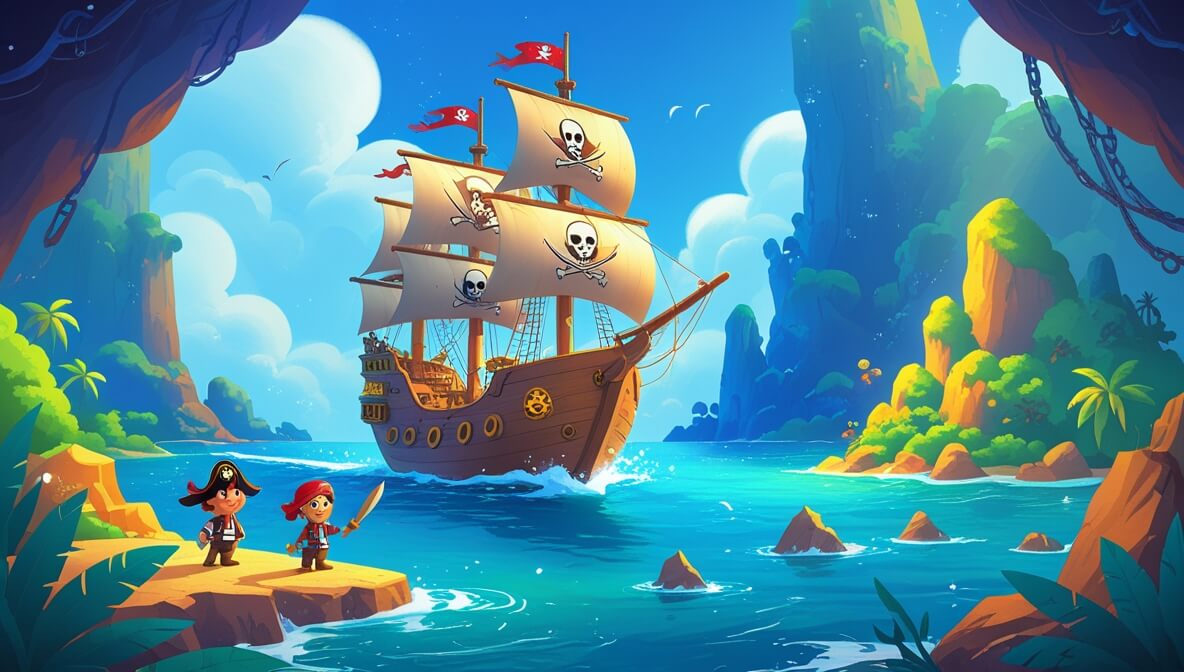Join Captain Marlowe and his loyal crew on a daring adventure as they search for a long-lost treasure hidden on a mysterious island. Will they overcome the challenges of stormy seas and reveal the secrets of the ancient map?
Age Recommendation
3 – 12 years
Characters
Characters:
- Captain Marlowe (a brave and wise pirate leader)
- First Mate Luna (a clever and resourceful navigator)
- Deckhand Jojo (a young, adventurous sailor eager to learn)
- Navigator Spike (an expert at reading maps and stars)
Story
Once upon a time, on the vast blue sea, there sailed a ship known as the Sea Whisperer. It was led by the fearless Captain Marlowe, who was on a quest to find the legendary treasure of the Mysterious Island. The captain stood proudly at the helm, his eyes scanning the horizon for any sign of land.
The Treasure Map is Found
One sunny morning, while sorting through the ship’s old parchments, First Mate Luna discovered an ancient map. “Look, Captain! This map shows the way to the Mysterious Island,” Luna exclaimed. The crew gathered around, their eyes wide with excitement. The map was said to lead to a treasure chest filled with gold and jewels, but it also warned of dangers hidden along the way.
Into the Storm
The Sea Whisperer journeyed through calm waters until a dark storm cloud appeared on the horizon. “Brace yourselves, crew!” Captain Marlowe shouted over the sound of the rising wind. The ship rocked and swayed as waves crashed against its sides. Jojo held tightly to the ropes, his heart pounding with both fear and excitement. The storm raged on, but the crew remained united, steering the ship through the tempest.
The Mysterious Island Appears
After the storm passed, the crew was greeted by the sight of a lush island outlined against the clear sky. “That’s it!” Navigator Spike pointed. The island was surrounded by a barrier of towering rocks, but Captain Marlowe knew the treasure was worth the risk. They navigated carefully through the rocks until they reached a hidden lagoon, where they anchored the ship.
The Secret of the Cave
On the island, the crew followed the map to a cave hidden behind a waterfall. “This must be the place,” Luna noted, her voice echoing in the cavern. As they ventured deeper, the cave opened into a grand chamber where a chest lay waiting. With a deep breath, Captain Marlowe opened the chest to reveal a dazzling array of gold coins and gleaming jewels.
The Journey Home
With the treasure safely aboard the Sea Whisperer, the crew celebrated their victory. “To the bravest crew on the sea!” Captain Marlowe cheered. The journey home was filled with laughter and tales of their adventure, each crew member knowing they had forged a bond stronger than any storm.
The end.
Moral of the Story
The story teaches the value of bravery, teamwork, and perseverance. Together, the crew faced the storm and overcame challenges, showing that courage and cooperation can lead to great rewards.
Questions to Think About
- Why was Captain Marlowe able to lead his crew successfully?
- How did the storm test the crew’s teamwork?
- What would you do if you found a treasure map?
- How did Jojo show his bravery?
- What can you learn from facing challenges?
Do You Know
- Pirates often used the stars to navigate just like Navigator Spike!
- Real pirate ships had to be quick and agile to escape the navy!
Word Explorer
- Navigator: Someone who plans the course of a ship using maps and stars.
- Lagoon: A shallow body of water separated from a larger sea by barriers.
- Perseverance: Continuing to try even when things are tough.
Emotions in the Story
- Excitement: Felt when the map was discovered and the journey began.
- Fear: Felt during the storm, but the crew stayed strong.
- Joy: Felt when the treasure was found and the adventure was complete.
Color Your Scene
Imagine the moment when the crew finally discovers the hidden lagoon surrounded by towering rocks. Draw the calm water, the lush greenery of the island, and the bright colors of the treasure chest being opened in the cave. Use blues for the water and greens for the trees, with a rainbow of colors for the sparkling jewels!
Parents’ Corner
This story is a wonderful way to discuss the following values with your child:
Courage: Captain Marlowe and his crew faced a storm and unknown challenges bravely. Talk about times when your child felt brave or can be encouraged to try new things.
Teamwork: The crew of the Sea Whisperer worked together to sail through the storm and find the treasure. Discuss how your family can work as a team to achieve goals.
Exploration: Encourage curiosity and the spirit of exploration, just like the crew who embarked on an adventure to find the treasure.
Facing Challenges: Use the story to discuss how facing challenges can lead to exciting discoveries and personal growth.











